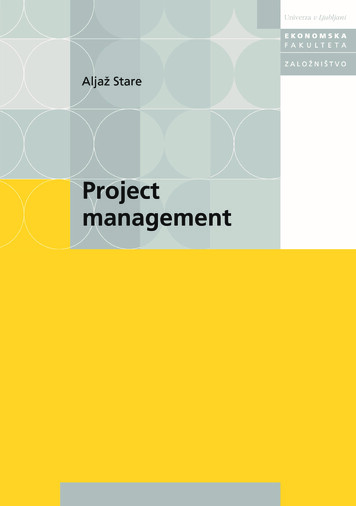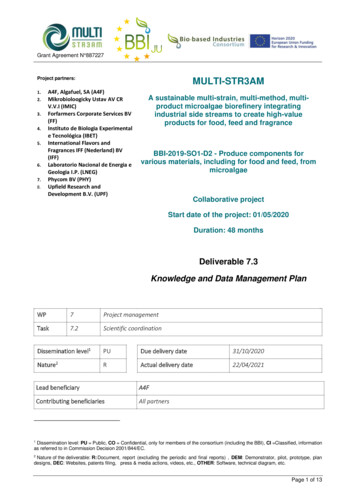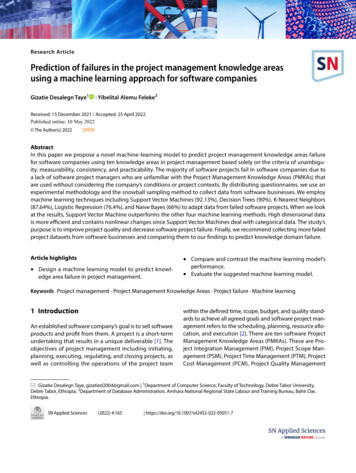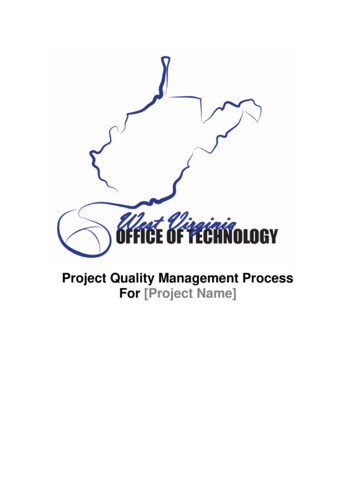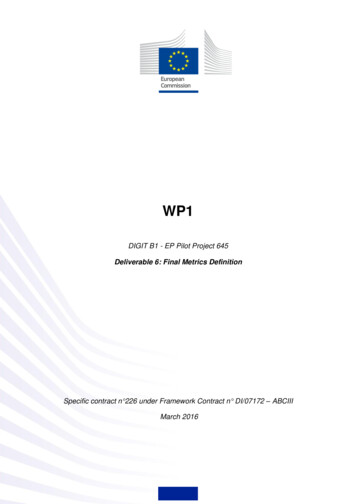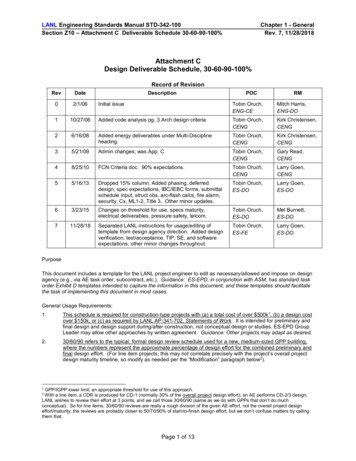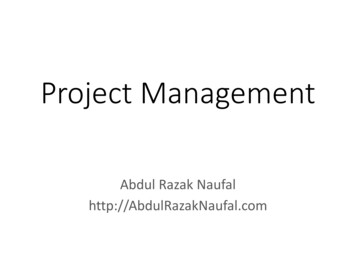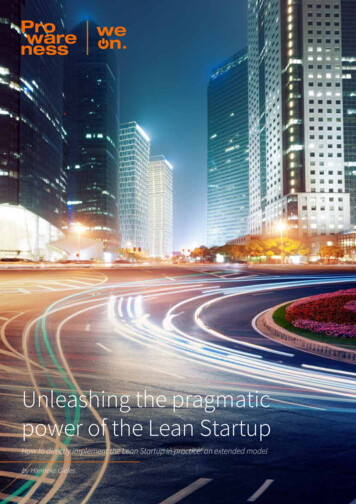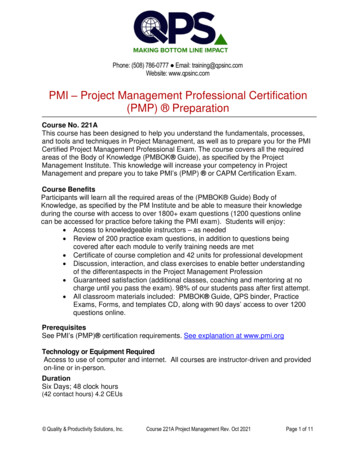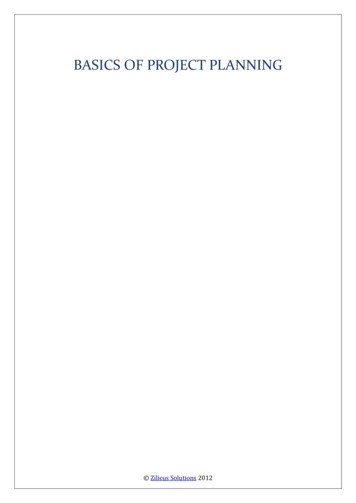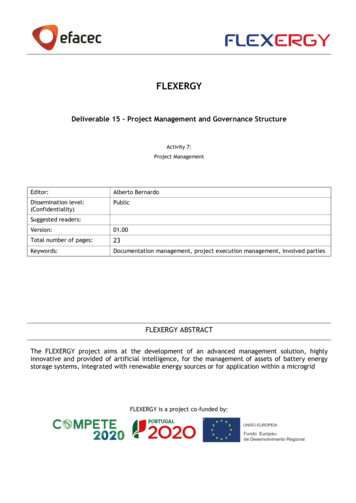
Transcription
FLEXERGYDeliverable 15 – Project Management and Governance StructureActivity 7:Project ManagementEditor:Alberto BernardoDissemination level:(Confidentiality)PublicSuggested readers:Version:01.00Total number of pages:23Keywords:Documentation management, project execution management, involved partiesFLEXERGY ABSTRACTThe FLEXERGY project aims at the development of an advanced management solution, highlyinnovative and provided of artificial intelligence, for the management of assets of battery energystorage systems, integrated with renewable energy sources or for application within a microgridFLEXERGY is a project co-funded by:
Deliverable 15 – Project Management and Governance Structure, Doc No.: AS180063744, Rev. 1.0Page 2/23
DocumentLanguage RequirementsNameDeliverable 15 – Project Management and Governance StructureDocument No.AS180063744Revision and Date1.0ProjectFLEXERGYMade byAlberto BernardoReviewed byIsmael MirandaApproved byAlberto BernardoTotal Pages232018-09-28(for non-native English speakers)In order to fully understand the content of this document, it is therefore recommended that the reader possesses a language proficiency equivalent to B1 level,according to European Language LevelsDisclosureThis document contains information, which is confidential in nature and proprietary to EFACEC, Automation Business Unit, and shall not be reproduced ortransferred to other documents or referenced, or disclosed in any manner to any person or used for any purpose other than that for which it is furnished withoutthe prior express written permission of EFACECDeliverable 15 – Project Management and Governance Structure, Doc No.: AS180063744, Rev. 1.0Page 3/23
nt releaseAlberto BernardoDeliverable 15 – Project Management and Governance Structure, Doc No.: AS180063744, Rev. 1.0Page 4/23
Executive SummaryThis deliverable addresses the management of several processes of the FLEXERGY project, including documentation, executionand governance structure.The role of the internal and external stakeholders towards the project achievement is addressed in this document, describingthe governance structure.Along the document, the reader will be able to learn about the tool used at corporate level for documentation managementalso adequate for the project purposes, as well as the structure of documentation, the role of users, the overall workflowsteps for documentation management and the related lifecycle management.Moreover, the reader will also learn about the innovation management process implemented within the project, namelyregarding the technology radar, innovation risks management, intellectual property management and impact of innovationderived from the project.The project aims at using the existing integrated microgrid and energy storage demonstrator testbed available at Efacec –developed along the DEMOCRAT project – for demonstrating the outcome of the FLEXERGY project. Therefore, the documentalso addresses the operational and execution management aspects of such integration and demonstration.Deliverable 15 – Project Management and Governance Structure, Doc No.: AS180063744, Rev. 1.0Page 5/23
Table of ContentsEXECUTIVE SUMMARY .5GLOSSARY .81.INTRODUCTION .92.PROJECT GOVERNANCE STRUCTURE . 102.12.2OVERVIEW . 10PROJECT TYPOLOGIES . 102.2.12.2.22.2.32.2.42.33.5.1. 102. 103. 104. 10PROJECT MANAGEMENT AND RELATED STAKEHOLDERS . 11DOCUMENTATION MANAGEMENT PLAN . logyOVERVIEW .FOLDER STRUCTURE .USERS’ ACCESS .DOCUMENTATION WORKFLOW MANAGEMENT .DOCUMENTATION LIFECYCLE MANAGEMENT .SIMPLICITY OF USE .131415151617INNOVATION MANAGEMENT PLAN. 184.14.24.34.4OVERVIEW .TECHNOLOGY RADAR .INNOVATION RISKS MANAGEMENT .INTELLECTUAL PROPERTY MANAGEMENT .181819204.5IMPACT ASSESSMENT OF INNOVATION . 21OPERATIONAL AND EXECUTION MANAGEMENT PLAN . 225.1OVERVIEW . 225.25.3INTEGRATION AND VALIDATION MANAGEMENT . 22TESTBED ASSETS AND HUMAN SAFETY MANAGEMENT . 22Deliverable 15 – Project Management and Governance Structure, Doc No.: AS180063744, Rev. 1.0Page 6/23
List of FiguresFigure 1 – The governance structure of the FLEXERGY project . 11Figure 2 – Link to Synergynet from the Efacec corporate intranet . 13Figure 3 – Synergynet options, comprising SharePlace . 14Figure 4 – Lifecycle workflow . 16Figure 5 – Example of document revision tracking . 17Figure 6 – Preliminary technology/business radar . 18List of TablesTable 1 – Internal and external stakeholders’ role within the project typologies . 12Table 2 – Critical risks and mitigation measures . 20Deliverable 15 – Project Management and Governance Structure, Doc No.: AS180063744, Rev. 1.0Page 7/23
GlossaryKPIKey Performance IndicatorASEAutomation and Smart Energy – an Efacec business unitBoDBoard of DirectorsCEVECooperativa Eléctrica do Vale d’EsteDSODistribution System OperatorEDPEnergias de PortugalHEDNOHellenic Electricity Distribution Network OperatorHTTPHypertext Transfer Protocol - set of rules for transferring files on theWorld Wide WebIPRIntellectual Property RightsLVLow VoltageMVMedium VoltagePDFPortable Document Format – a file format for copying and sendingelectronic documentsQASQuality, Environment and Safety – the Portuguese related acronymR&DResearch and DevelopmentTRLTechnology Readiness LevelDeliverable 15 – Project Management and Governance Structure, Doc No.: AS180063744, Rev. 1.0Page 8/23
1. IntroductionThis deliverable describes the project governance structure, comprising the internal and external stakeholders whosecontribution is relevant for the project goals accomplishment.The deliverable describes also the documentation management plan and the innovation management plan, especially designedfor the FLEXERGY project.The document is divided in four main sections: Project Governance StructureThe Documentation Management PlanThe Innovation Management PlanThe Operational and Execution Management PlanThe Project Governance Structure is described in a specific section.The Documentation Management Plan describes how documentation will be managed within the FLEXERGY project, addressingspecific subjects such as: Electronic platformEditing, reviewing and approval workflowRoles and responsibilitiesOverall directory for all FLEXERGY documentation-like deliverablesThe Innovation Plan describes how innovation is managed along the FLEXERGY project lifecycle, addressing specific subjectssuch as: Technology radarInnovation risks managementIntellectual property managementImpact assessment of innovation within FLEXERGY towards the strategic technology roadmap of the energy storagebusinessThe Operational and Execution Management Plan describes how the outcome of the FLEXERGY project validation anddemonstration will be managed, namely by using the DEMOCRAT project demonstration facilities. The Plan addresses specificsubjects as: Integration and validation managementTestbed assets and human safety managementDeliverable 15 – Project Management and Governance Structure, Doc No.: AS180063744, Rev. 1.0Page 9/23
2. Project Governance Structure2.1 OverviewThere are two kinds of stakeholders that have coordinated roles within the FLEXERGY project management: internal andexternal.Their coordinated role is meant to leverage the project outcomes towards an effective goals’ achievement, as the FLEXERGYproject has ambitious commercial targets through the application of the developed technology. Their participation in theproject is performed around the activities and tasks, these being organised in different topologies regarding Innovation,Research and Development.The following sections describe these categories as well as the types of stakeholders and their role in the project.2.2 Project TypologiesThe project is divided in four typologies regarding Innovation, Research and Development.2.2.1 Typology 1This typology comprises tasks of "industrial research", including critical studies for the formulation of the innovative conceptgoing beyond the state of the art and taking it as a reference.In this scope, it also includes the definition of use cases and the general and detailed definition of requirements, as well asthe architecture definition of the energy storage asset management solution.Also included in this scope is the modelling of the energy storage system aiming at performing its simulation and validation.These models will serve as reference for the definition of KPI, for benchmarking the performance of the solutions that areintended to be developed and validated.2.2.2 Typology 2This typology also comprises tasks of "industrial research", but specific to the technological development of the projectsolutions, following a cascade methodology, with interaction upstream and downstream, from the initial specification tasks oftypology 1, including eventual concept tests, until validation and verification of the technology in the laboratory.2.2.3 Typology 3This typology addresses "experimental development" tasks, focused on the development of the technology and developedsolutions, in order to be demonstrated in the Efacec testbed - DEMOCRAT demonstrator -, for its suitability as an industrialsolution, available to the market after the conclusion of the project. These tasks include performing integration trials andfunctional tests necessary to ensure that the solutions developed correspond to the expectation of a TRL 8.2.2.4 Typology 4This typology corresponds to the "Technical Project Management" tasks, focused on the dissemination of project results, be itin the technical-scientific scope or in the business development.Deliverable 15 – Project Management and Governance Structure, Doc No.: AS180063744, Rev. 1.0Page 10/23
2.3 Project Management and related StakeholdersThe FLEXERGY project is managed according to the principles and methods defined by the International Project ManagementAssociation. Thus, within the framework of the R&D activity plan, milestones, start and end dates of the different activitiesand tasks were defined, delivery dates for deliverables (deliverables), definition of responsibilities, as well as the allocationof human and financial resources required to execute the project.Given the importance and complexity of the project, as well as of the different internal and external organic entities involved,the FLEXERGY project has a global manager, responsible for supervising the evolution of the project and coordinating allactivities, focusing on external interactions.The manager has a seat in a Steering Committee of composition already identified, including Board members of the AutomationBusiness Unit, members of the Technology Management Office of the Efacec Group and participants from INESC TEC – theproject subcontracted entity –, as well as invited personalities from industry, academy and research institutes. The role of theSteering Committee is to provide guidance for the project, with a strong focus on innovation and project quality.The manager supervises the development of the project in terms of plan and technical content and, in close collaborationwith the Steering committee, he ensures the development and maintenance of the vision and achievement of the projectobjectives, he addresses opportunities and threats, he reconciles positions of internal and external stakeholders, and heensures the execution of the roadmap and the project calendar.In particular, the manager will interact with INESC TEC as the subcontracted entity, as well as with the managing entity of thefunding program, when applicable. He will also interact with the Efacec corporate Administrative and Finance department,responsible to establish the non-technical relation with the managing entity of the funding program.The manager also interacts with the DEMOCRAT project manager when the demonstrator testbed is meant to be used for thevalidation of the FLEXERGY’s outcomes, namely new management features for microgrids enabled by energy storage.The manager may also interact with the corporate Board of Directors for addressing any more complex issue preventing theproject to progress conveniently.The governance structure described above is depicted in Figure 1.Figure 1 – The governance structure of the FLEXERGY projectThe Steering Committee is composed by the following entities: Project Manager (Efacec)Energy Storage division R&D Manager (Efacec)Automation Business Unit managing board member (Efacec)Automation Business Unit strategic projects manager (Efacec)INESC TEC managing board memberEDP New/CNET memberFaculty of Engineering of the University of Porto memberUniversity of Minho / Basque Centre for Materials memberDeliverable 15 – Project Management and Governance Structure, Doc No.: AS180063744, Rev. 1.0Page 11/23
The relation of the internal and external stakeholders with the mentioned project typologies is depicted in Table 1.Stakeholderstypology 1typology 2typology 3typology 4industrial researchindustrial projectCorporate Board ofDirectorsAddressingcomplexissues preventing theproject to progress;AutomationBusiness Unit boardAddressingcomplexissues preventing theproject to progress;ParticipationintheSteering Committee;Guidance on the overallproject goals execution;Administrative andFinance departmentInterfacewiththemanaging entity of thefunding program;TechnologyManagement OfficeParticipationintheSteering Committee;Steering CommitteeProject Follow-up;Guidance on the overallproject goals execution;ParticipationintheSteering Committee;ExternalStakeholdersUse cases definition andgeneralanddetaileddefinition of requirements;INESC TECModelling of the energystorage system;Technical TeamUse cases definition andgeneralanddetaileddefinition of requirements;Modelling of thestorage system,comprising thebehaviour of thesystem;Development of specificmodels and a softwarelibrary to be integratedin the Efacec solution;Integration trialsfunctional tests;Validation of INESC TEC’ssoftware library;Integration trialsfunctional tests;andParticipationintheSteering rt to the projectmanager of all requests for using thedemonstration testbed;DEMOCRAT ProjectManagerFLEXERGYManagerSubcontracted entity toclosely team-up with theproject team;Supervision of the ongoingworks;Supervisionofongoing works;theSupervisionofongoing workstheOverallcoordination;projectInteraction with theAdministrativeandFinance department;Report to the AutomationBoard and/or to theCorporateBoardofDirectors;Interaction with theDEMOCRATprojectmanager, responsible forthe demo testbed;CalltheSteeringCommittee and chair itsmeetings;Table 1 – Internal and external stakeholders’ role within the project typologiesDeliverable 15 – Project Management and Governance Structure, Doc No.: AS180063744, Rev. 1.0Page 12/23
3. Documentation Management Plan3.1 OverviewDocuments for strategic projects such as FLEXERGY, are managed in the in-house application named SharePlace.SharePlace is a web-based application suitable for documentation management. It was developed in Efacec and is widely usedby all business units accross the Efacec Group. It includes different applications designed to optimize and simplify many usertasks and thus increasing user productivity.The computational platform beneath Shareplace offers all needed features regarding persistency and backup, data protectionagainst viruses and other threats, as well as cyber-security, as such platform is managed by the Efacec corporate services,namely by the Digital Office.SharePlace is a set of integrated applications. It covers almost all business functional areas, comprising Production,Engineering, Commercial, Logistics, etc., as well as R&D.This is an online tool available through the Intranet “Synergynet” folder link, as it can be depicted in Figure 2.Figure 2 – Link to Synergynet from the Efacec corporate intranetOnce selected, a menu within Synergynet allows the duly user to select the suitable application which, in the scope ofdocumentation is SharePlace, as it can be depicted in Figure 3.Deliverable 15 – Project Management and Governance Structure, Doc No.: AS180063744, Rev. 1.0Page 13/23
Figure 3 – Synergynet options, comprising SharePlaceThe application for project document management is ProjectShare, where all users can visualize documents associated toprojects.Key users are primarily defined so they are in charge of the assignment of write and read permissions. In addition, for eachproject, the project manager can add or remove users’ access of the projects.3.2 Folder StructureThe selected folder structure to manage the project FLEXERGY is common to other R&D and demonstration projects and it isas follows:01.02.03.04.05.06.07.Requirements and SpecificationsArchitecture and DesignPlans and Test ResultsMeetingsFinancial ManagementSupplementary DocumentsCommunicationsThe previous structure addresses all required documentation needs for FLEXERGY, as it allows managing, comprising thecreation, editing and reading of important documents achieved along the project lifecycle. Such folder structure is used inthe project for the following purposes:01. Requirements and Specifications – project deliverables regarding technical aspects of the project, comprising usecases and pilot definitionsDeliverable 15 – Project Management and Governance Structure, Doc No.: AS180063744, Rev. 1.0Page 14/23
02. Architecture and Design – project deliverables regarding the demonstrator architecture for the demonstrator andalso for the IT system managing it, as well as the algorithms design and their implementation03. Plans and Test Results – project deliverables regarding unitary, integration and site testing, comprising theirplanning and test results04. Meetings – minutes of all meetings05. Financial Management – project deliverables regarding financial management of FLEXERGY, as well as theirsupporting files06. Supplementary Documents – project deliverables, addressing other scopes, namely this specific D1.0 deliverable Documentation Management and Innovation Management Plan – or any other deliverable related to disseminationand exploitation07. Communications – this folder is used to keep all important e-mails and related attachments associated to thelifecycle management of FLEXERGY3.3 Users’ AccessNot all users have reading access, as it is limited to R&D group that reflects the organization structure. In fact, all groupsdefined are mirroring the company hierarchical chart granting adaptability and avoiding the need to be constantly managingusers by the Project Manager.The SynergyNet allows the definition of roles that fit exclusive responsibilities, such as the Project Manager and the ProjectTeam.In case of one-off situations – those where users belong to external groups not related to the project – specifically when otheruser requires the access, the project manager is in charge of assigning him the reading or writing access.The Project Manager is set at first when creating the project. Moreover, it can be defined one or more users. This role meansthat the project manager and any other duly user may approve documents, reject drafts, insert or remover users, etc.3.4 Documentation Workflow ManagementThe ProjectShare tool is targeted for documents management.New documents are sequentially and automatically numbered. The main features are: Create new documents (the numbering is automatic)Select the type of document (generic, manual, datasheet, roadmap, report ), most suitable for FLEXERGYSet different levels of confidentiality (low, medium or high)Define lifecycle (1 step approval or No Approval at all)Define a creator team (equals the same writing permissions as the document owner)Define revision schemes (0.0; 1.A, or no revision at all)Add new step to approval processIn the SharePlace context, a document is a container that may include more than one file, typically, an editable file formatand a PDF file that is readable for the remaining users.Besides these, one can save on the same container other files in different languages, or a zipped folder.There’s no limit of files to be saved in SharePlace.In this stage, the new document is created under a Draft status; it’s when the owner and his team work in the same file orfiles.There is a check-in and check-out feature to prevent parallel edition so, a message appears to warn when someone is editingthe files.Deliverable 15 – Project Management and Governance Structure, Doc No.: AS180063744, Rev. 1.0Page 15/23
3.5 Documentation Lifecycle ManagementAfter the contributions of one or more members, the owner changes the document status from Draft to Under Approval. TheProject Manager instantaneously receives a notification to visualize it and then approve it. He can also reject the file, returningit to the owner who will start the process from the beginning.If the document is approved, all participants of the project are notified with an automatic email. This happens only if theproject owner (Project Manager) forces that subscription. But, the users can subscribe themselves the documents or foldersthat they want to be notified of.When a new revision is required, the document owner or someone of the project team can create a new revision. The statusreturns to Draft and the process starts again.Figure 4 briefly describes the workflow associated to documentation verification, validation, revision and approval.Figure 4 – Lifecycle workflowSharePlace maintains older revisions. For instance, a document with a third approved revision keeps revisions 1 and 2. Theinterface of the application only shows the last one, however, previous revisions are displayed under the Revision Log optionof the Document as it can be observed in Figure 5, highlighted by the red rectangle.Deliverable 15 – Project Management and Governance Structure, Doc No.: AS180063744, Rev. 1.0Page 16/23
Figure 5 – Example of document revision trackingA log is kept with all the revisions, so, the information is never lost, and the user can compare different revisions and see thereasons for revision throughout time.There is a great advantage of using SharePlace: the user can bind the same document to different references. That is, aspecific document can be visualized in the FLEXERGY project and at the same time, if applicable, in a Product or even inanother project; basically, there is an interaction with different documents, and the user can always unbind them.This binding is quite flexible, as the user can bind the last revision of a document to the first revision of the second documentbound.The access is dependent on the permissions assigned in each reference, addressing both projects or products.Apart from the document characteristics as stated above, the application allows to give different attributes that help todistinguish the documents. This is a totally optional feature. Attributes as event date, HTTP link, related documents or eventdates, are some of those examples.3.6 Simplicity of UseThe upload of files can be made by drag-and-drop, where the user can select a package of files and drag it to SharePlace,thus, simplicity and speed is assured.It is possible to drag more than one file and the tool is able to differentiate, whether one container is created for lots of files,or a container per file; it depends on the user will.Deliverable 15 – Project Management and Governance Structure, Doc No.: AS180063744, Rev. 1.0Page 17/23
4. Innovation Management Plan4.1 OverviewThe present plan for innovation management is focused on the following main topics: Technology radarInnovation risks managementIntellectual property managementImpact assessment of innovation within FLEXERGY towards the strategic technology roadmap of the energy storagebusiness4.2 Technology RadarThe FLEXERGY project addresses several business aspects of smart grids, addressing the scope of energy storage withinmicrogrids enabled by renewable energies, with a significant presence of electric vehicle charging. As part of its business role,Efacec has determined that the team involved in the FLEXERGY project, as any other involved in other R&D or demonstrationprojects, should follow up technology and market trends, namely by establishing a technology radar.Such technology radar will be defined considering internal perspectives of technology, internal processes and businesscommitment, as well as external perspectives regarding business awareness, namely comprising customers, competitors andmarket fit.A preliminary study was already performed, resulting in the technology/business radar diagram depicted in Figure 6.Figure 6 – Preliminary technology/business radarThe preliminary study addressed five business segments, comparing the Efacec expectation for 2020 against its competitors: Grid storageRES integrationIslanded / off grid systemsMicro-gridsIndustrial/EV integrationThe same study comprised an assessment of market potential for Efacec and the current presence of its competitors in Europe,Africa, USA and Canada, Latin America, Asia and Australia.Deliverable 15 – Project Management and Governance Structure, Doc No.: AS180063744, Rev. 1.0Page 18/23
4.3 Innovation Risks ManagementInnovation risks comprise all related contingencies that may put the project at risk. The risks that may arise are presented inTable 2, which also comprise the related mitigation measure.It is worth mentioning that as FLEXERGY is mainly an innovative demonstration project involving the installation of an electricalinfrastructure and related smart grid and energy storage components in the Efacec premises located in Maia, Portugal, notonly research and development risk aspects may affect the overall progress of the project, but also other aspects regardingmultiple participation of Efacec internal stakeholders may affect the project as well. The internal stakeholders of Efacec arethe following: Board of DirectorsAutomation and Smart Energy business unit (ASE), comprising the General Manager and three business divisions:o Smart Gridso Energy Storageo InvertersQuality, Environment and Safety corporate department (QAS)Infrastructures department, also comprising the Electrical Infrastructure Responsible ConsultantRisks (impact, probability)Proposed mitigation measureAgr
Deliverable 15 - Project Management and Governance Structure, Doc No.: AS180063744, Rev. 1.0 Page 3/23 Document Language Requirements (for non-native English speakers) In order to fully understand the content of this document, it is therefore recommended that the reader possesses a language proficiency equivalent to B1 level,
